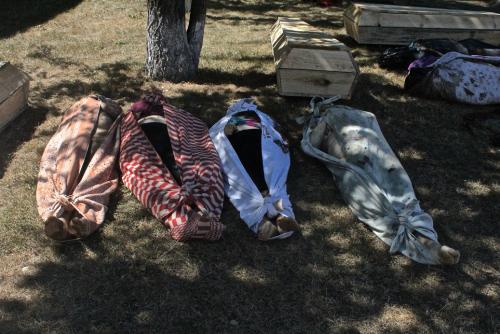Ukraine: Rising Civilian Toll in Luhansk
At least 300 Civilians Killed since May, Many in Indiscriminate Bombings
Unlawful government and insurgent attacks in and around Luhansk are contributing to rising civilian casualties. According to a morgue doctor in Luhansk, explosive weapons have killed more than 300 civilians in the city since May.
During an August 20-22, 2014 visit to Luhansk, under siege by Ukrainian armed forces, Human Rights Watch interviewed more than a dozen people who witnessed or became victims of artillery, mortar, and rocket attacks that killed or injured civilians in populated areas. Many of the attacks appeared to be indiscriminate, in that they did not or could not distinguish between civilians and combatants, Human Rights Watch said. Indiscriminate attacks violate international humanitarian law, or the laws of war.

Decomposing corpses lie in the shade outside Luhansk morgue attracting swarms of flies on August 21, 2014. A lack of electricity means there have been no refrigeration facilities at the morgue for more than three weeks.
“With communications cut, there is less information available about the situation in Luhansk than other areas in the east,” said Ole Solvang, senior emergencies researcher at Human Rights Watch. “But the truth is, local residents are subjected to terrifying daily shelling, much of it apparently unlawful, and that the number of civilian casualties is steadily rising.”
The fighting has subjected the city and surrounding area to daily shelling, often killing and injuring civilians.
Since May, Ukrainian armed forces have attempted to retake the city from pro-Russian insurgents. Residents told Human Rights Watch that many residents have not had electricity, gas, and running water for weeks, food and fuel are running low, and it is difficult to communicate because neither cellphones nor landlines work. Human Rights Watch observed long lines at morning water and bread distribution points.
The precarious security situation in the city made it difficult to conduct full investigations of individual attacks. But interviews with witnesses and victims about the attacks, and Human Rights Watch observations on the ground, suggest that many attacks were unlawful in that the attacking force used weapons in populated areas that could not be targeted with sufficient accuracy to distinguish between civilian and military objects.
While in Luhansk, Human Rights Watch examined remnants of 122 mm unguided Grad rockets and artillery projectiles of various calibers, up to 152 mm. These remnants of ordnance had been collected from populated areas where attacks had killed and injured civilians. Human Rights Watch also saw remnants of 300 mm Smerch rockets and cluster munitions delivered by 220 mm Uragan rockets but was not able to establish the circumstances in which they were used and whether they caused civilian casualties.
Cluster munitions have been banned because of their widespread indiscriminate effect although Ukraine is not party to the 2008 Convention on Cluster Munitions. While the other weapons are not prohibited per se, the use of such large-caliber explosive weapons in populated areas is likely to lead to significant civilian casualties because it is difficult to target them precisely or limit their effects to a military target. For this reason Human Rights Watch believes, as a matter of policy, that explosive weapons with wide-area effects should not be used in populated areas.
While it was difficult to establish with certainty responsibility for individual attacks amid ongoing fighting, circumstantial evidence indicates that government forces were responsible for many of the attacks Human Rights Watch investigated in the city and that insurgent forces were responsible for several attacks against areas under government control on the outskirts.
On August 18, for example, shells struck the central market in Luhansk, killing at least four people and causing fires that burned down dozens of small shops. Shells struck the area again in the following days, including during the Human Rights Watch visit. The proximity of the central market to the regional administration building, headquarters for insurgents in Luhansk and one of the government forces’ presumed priority targets, suggests Ukrainian armed forces were responsible for the attack.
Insurgent forces were most likely responsible for an August 10 attack on Krasnyi Yar, a small village north of Luhansk, which injured at least two civilians. Witnesses said the Aydar battalion, a volunteer unit of armed citizens that fights together with Ukrainian armed forces, had just established control over the village and set up a checkpoint when salvos of Grad rockets hit the village from the south, from the direction of insurgent-controlled territory.
“The use of explosive weapons with such wide-area effects in a city full of civilians is completely irresponsible and will almost inevitably lead to civilian casualties,” Solvang said. “Whether used by government or insurgent forces, those responsible should be held to account for this callous disregard for civilian life.”
Human Rights Watch urged Ukrainian authorities and rebel forces’ commanders alike to order all their respective forces to immediately stop using Grads in or near populated areas, to cease all use of cluster munitions, and to refrain from indiscriminate attacks.
Human Rights Watch called on Ukraine’s international supporters to urge the Ukrainian government to strictly adhere to international humanitarian law in the conflict, and called on Russia to urge rebel forces to do the same.
Source: Human Rights Watch
- 503 reads
Human Rights
Conscience, Hope, and Action: Keys to Global Peace and Sustainability

Ringing FOWPAL’s Peace Bell for the World:Nobel Peace Prize Laureates’ Visions and Actions

Protecting the World’s Cultural Diversity for a Sustainable Future

The Peace Bell Resonates at the 27th Eurasian Economic Summit

Puppet Show I International Friendship Day 2020

